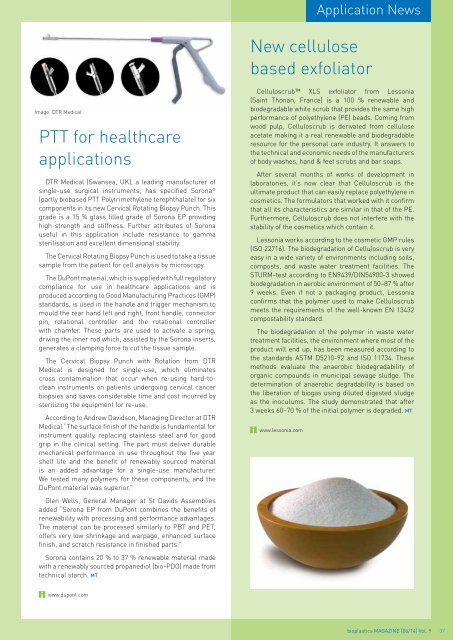bioplasticsMAGAZINE_1406
bioplasticsMAGAZINE_1406
bioplasticsMAGAZINE_1406
Create successful ePaper yourself
Turn your PDF publications into a flip-book with our unique Google optimized e-Paper software.
Application News<br />
New cellulose<br />
based exfoliator<br />
Image: DTR Medical<br />
PTT for healthcare<br />
applications<br />
DTR Medical (Swansea, UK), a leading manufacturer of<br />
single-use surgical instruments, has specified Sorona ®<br />
(partly biobased PTT Polytrimethylene terephthalate) for six<br />
components in its new Cervical Rotating Biopsy Punch. This<br />
grade is a 15 % glass filled grade of Sorona EP providing<br />
high strength and stiffness. Further attributes of Sorona<br />
useful in this application include resistance to gamma<br />
sterilisation and excellent dimensional stability.<br />
The Cervical Rotating Biopsy Punch is used to take a tissue<br />
sample from the patient for cell analysis by microscopy.<br />
The DuPont material, which is supplied with full regulatory<br />
compliance for use in healthcare applications and is<br />
produced according to Good Manufacturing Practices (GMP)<br />
standards, is used in the handle and trigger mechanism to<br />
mould the rear hand left and right, front handle, connector<br />
pin, rotational controller and the rotational controller<br />
with chamfer. These parts are used to activate a spring,<br />
driving the inner rod which, assisted by the Sorona inserts,<br />
generates a clamping force to cut the tissue sample.<br />
The Cervical Biopsy Punch with Rotation from DTR<br />
Medical is designed for single-use, which eliminates<br />
cross contamination that occur when re-using hard-toclean<br />
instruments on patients undergoing cervical cancer<br />
biopsies and saves considerable time and cost incurred by<br />
sterilizing the equipment for re-use.<br />
According to Andrew Davidson, Managing Director at DTR<br />
Medical “The surface finish of the handle is fundamental for<br />
instrument quality, replacing stainless steel and for good<br />
grip in the clinical setting. The part must deliver durable<br />
mechanical performance in use throughout the five year<br />
shelf life and the benefit of renewably sourced material<br />
is an added advantage for a single-use manufacturer.<br />
We tested many polymers for these components, and the<br />
DuPont material was superior.”<br />
Glen Wells, General Manager at St Davids Assemblies<br />
added “Sorona EP from DuPont combines the benefits of<br />
renewability with processing and performance advantages.<br />
The material can be processed similarly to PBT and PET,<br />
offers very low shrinkage and warpage, enhanced surface<br />
finish, and scratch resistance in finished parts.”<br />
Sorona contains 20 % to 37 % renewable material made<br />
with a renewably sourced propanediol (bio-PDO) made from<br />
technical starch. MT<br />
Celluloscrub XLS exfoliator from Lessonia<br />
(Saint Thonan, France) is a 100 % renewable and<br />
biodegradable white scrub that provides the same high<br />
performance of polyethylene (PE) beads. Coming from<br />
wood pulp, Celluloscrub is derivated from cellulose<br />
acetate making it a real renewable and biodegradable<br />
resource for the personal care industry. It answers to<br />
the technical and economic needs of the manufacturers<br />
of body washes, hand & feet scrubs and bar soaps.<br />
After several months of works of development in<br />
laboratories, it’s now clear that Celluloscrub is the<br />
ultimate product that can easily replace polyethylene in<br />
cosmetics. The formulators that worked with it confirm<br />
that all its characteristics are similar in that of the PE.<br />
Furthermore, Celluloscrub does not interfere with the<br />
stability of the cosmetics which contain it.<br />
Lessonia works according to the cosmetic GMP rules<br />
(ISO 22716). The biodegradation of Celluloscrub is very<br />
easy in a wide variety of environments including soils,<br />
composts, and waste water treatment facilities. The<br />
STURM-test according to EN9439/DIN54900-3 showed<br />
biodegradation in aerobic environment of 50–87 % after<br />
9 weeks. Even if not a packaging product, Lessonia<br />
confirms that the polymer used to make Celluloscrub<br />
meets the requirements of the well-known EN 13432<br />
compostability standard.<br />
The biodegradation of the polymer in waste water<br />
treatment facilities, the environment where most of the<br />
product will end up, has been measured according to<br />
the standards ASTM D5210-92 and ISO 11734. These<br />
methods evaluate the anaerobic biodegradability of<br />
organic compounds in municipal sewage sludge. The<br />
determination of anaerobic degradability is based on<br />
the liberation of biogas using diluted digested sludge<br />
as the inoculums. The study demonstrated that after<br />
3 weeks 60–70 % of the initial polymer is degraded. MT<br />
www.lessonia.com<br />
www.dupont.com<br />
bioplastics MAGAZINE [06/14] Vol. 9 37


















